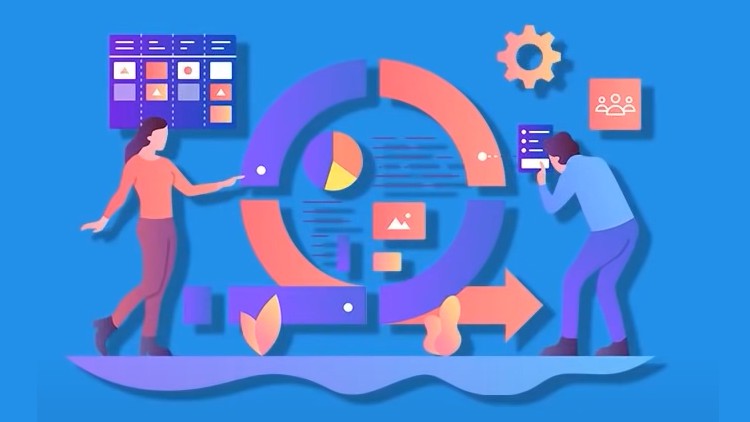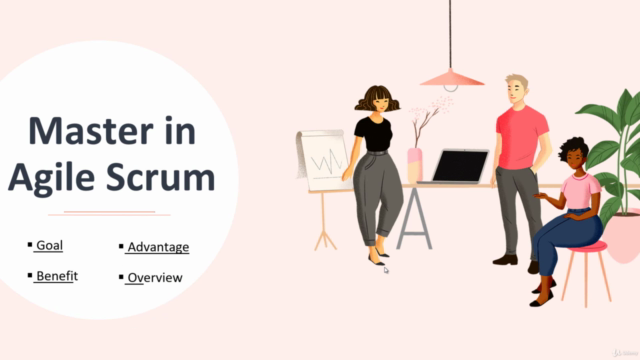Agile & Scrum: From Agile Mindset to Scrum Implementation
Learn everything about Agile & Scrum. Become Master in Agile Mindset & Scrum Team, Roles, Ceremony, Artifacts & DoD
3.98 (85 reviews)

11 225
students
4.5 hours
content
Feb 2022
last update
$19.99
regular price
Why take this course?
Based on the detailed outline provided, here's a comprehensive understanding of each section:
SECTION 1: Introduction to Agile & Scrum
- You will get an overview of Agile methodologies and why they are important.
- You'll understand the principles behind Agile and how Scrum fits into this framework.
- The history and evolution of Scrum, its values, and the Agile Manifesto will be introduced.
SECTION 2: Roles in the Scrum Team
- Product Owner: Responsible for maximizing the value of the product resulting from the work of the Development Team. This includes clearly expressing Product Backlog items, ordering the items in the Product Backlog to best achieve goals, and ensuring that everyone understands items in the Product Backlog.
- Scrum Master: Acts as a servant-leader for the Scrum Team, responsible for ensuring that the team follows Scrum practices, coaches the team members in the principles and values of Scrum, and helps remove impediments to the team's progress. The Scrum Master also works with the Product Owner to resolve conflicts and clarify priorities.
- Development Team: A cross-functional group of professionals who design, develop, and deliver a potentially releasable increment of the product at the end of each Sprint. They are self-organizing and accountable for the DoD.
SECTION 3: Scrum Framework & Rules
- You will learn about the structure of a Scrum project, including the roles, events (ceremonies), artifacts, and rules that make up the framework.
- Understanding the interplay between these elements is crucial for successful Scrum implementation.
SECTION 4: Three Roles in the Scrum Team
- You will dive deeper into each role within the Scrum team—Product Owner, Scrum Master, and Development Team—and your responsibilities towards each other and the organization.
- Constraints and characteristics of the Development Team are discussed, with examples to illustrate.
SECTION 5: Scrum Terms
- You will familiarize yourself with key terms used in Scrum, such as Time Box and Definition Of Done (DoD).
- The importance of time-boxing within Scrum is explained, as well as the significance of having a clear DoD for ensuring quality and delivering a potentially shippable product increment at the end of each Sprint.
SECTION 6: Product Ceremony & Artifacts
- You will learn about the Product Backlog, refinement, and prioritization, and how these activities set the stage for the Scrum process.
- Understanding how to effectively use these ceremonies and artifacts according to your role within a Scrum project is crucial.
SECTION 7: Scrum Ceremony & Artifacts
- A detailed look into each Scrum ceremony (Sprint Planning, Daily Scrum, Sprint Review, and Sprint Retrospective) and artifacts (Product Backlog, Sprint Backlog, Increment).
- You will understand the actions to take during each ceremony, the questions to ask, and the outcomes to expect.
SECTION 8: Bonus
- Additional topics that are important for implementing Agile Scrum in an organization.
- Writing Product Backlog Items using Story Points and understanding team velocity.
- Utilizing Burn Down Charts to track progress and performance.
- Engaging in Release Planning to ensure timely delivery of product increments.
This outline provides a structured approach to understanding Scrum, from the basics to the advanced applications, and how it fits into the broader context of Agile project management. Each section builds upon the previous one, ensuring a comprehensive grasp of Scrum's principles, practices, and benefits for both teams and organizations.
Course Gallery




Loading charts...
Related Topics
3170352
udemy ID
26/05/2020
course created date
08/06/2021
course indexed date
Bot
course submited by